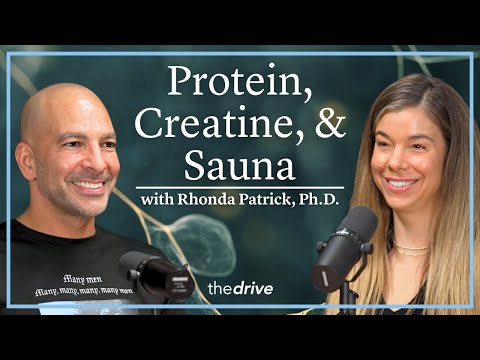Rhonda Patrick is a scientist, health educator, and host of the FoundMyFitness podcast whose work explores the intersection of nutrition, aging, and disease prevention. In this episode, Rhonda joins Peter for part two of his deep dive on protein, continuing last week’s discussion with David Allison and expanding the conversation to include creatine supplementation and sauna use. She discusses why the current RDA for protein is insufficient, how much more is needed to maintain muscle mass and prevent frailty, how activity level and aging influence protein requirements through mechanisms such as anabolic resistance, and how to determine optimal protein intake. The conversation also covers creatine’s proven effects on strength, endurance, and performance; its overlooked benefits for cognition and brain health; and the optimal dosing for different populations. Rhonda closes with the science behind sauna use, including its cardiovascular and cognitive benefits, the role of heat shock proteins, and practical guidance on temperature and duration.
Subscribe on: APPLE PODCASTS | SPOTIFY | RSS | OVERCAST
“My mission for The Peter Attia Drive has always been to provide you with the most rigorous, evidence-informed insights on longevity. To do that without cluttering your experience with ads, we rely entirely on our premium members. If you’d like to support the work that makes this mission possible, consider becoming a premium member.”
– Peter
We discuss:
Timestamps: There are two sets of timestamps associated with the topic list below. The first is audio (A), and the second is video (V). If you are listening to this podcast with the audio player on this page or in your favorite podcast player, please refer to the audio timestamps. If you are watching the video version on this page or YouTube, please refer to the video timestamps.
- Why the current protein RDA is too low, and why maintaining sufficient amino acid intake is vital for muscle preservation and health [A: 3:30, V: 0:11];
- The case for raising the protein RDA by at least 50% [A: 9:45, V: 7:12];
- Anabolic resistance: why inactivity—more than aging—blunts the body’s response to protein, and how resistance training restores it [A: 14:00, V: 11:46];
- How sarcopenia develops, the profound effect of frailty on quality of life, and why it’s crucial to build and maintain muscle early [A: 20:00, V: 18:40];
- Finding the optimal protein dose [A: 25:00, V: 24:46];
- Why aiming higher is smarter: the case for targeting 2g of protein per kg of body weight in the real world [A: 32:15, V: 32:39];
- Protein needs for pregnant women and growing adolescents [A: 37:30, V: 38:26];
- Why higher protein intake is crucial when trying to lose fat while preserving or gaining muscle [A: 39:45, V: 41:05];
- GLP-1 drugs: protein needs, muscle preservation, dosing strategies, evidence of broader health impacts, and more [A: 43:45, V: 45:31];
- How overweight individuals should calculate protein needs based on target body weight [A: 50:45, V: 53:54];
- Unpacking a misunderstood topic: the relationship between protein intake, mTOR activation, and longevity [A: 52:00, V: 55:29];
- Why it’s unclear whether rapamycin is geroprotective in humans, and how misinterpreted animal data have fueled misconceptions about protein or mTOR activation being harmful [A: 1:00:45, V: 1:05:21];
- The unmatched longevity benefits of exercise, its synergy with higher protein intake, and Peter’s recommended protein intake [A: 1:06:15, V: 1:11:33];
- How Rhonda became fascinated with creatine—a well-studied, safe, and effective supplement for improving exercise performance [A: 1:09:00, V: 1:14:52];
- Creatine for the brain: how higher doses may enhance cognition under stress and support resilience against aging and disease [A: 1:16:30, V: 1:23:26];
- Optimal creatine use: dosing for adults and teens, safe product selection, debunking kidney myths, and more [A: 1:25:45, V: 1:34:27];
- Sauna: how deliberate heat exposure mimics exercise, boosts cardiovascular and brain health, and shows promise for improving mood and mental resilience [A: 1:32:15, V: 1:41:54];
- The benefits of sauna for reducing risk of dementia, and why hotter may not be better [A: 1:41:15, V: 1:52:32];
- The FoundMyFitness podcast [A: 1:45:30, V: 1:57:33]; and
- More.
Show Notes
Why the current protein RDA is too low, and why maintaining sufficient amino acid intake is vital for muscle preservation and health [A: 3:30, V: 0:11]
- Protein is an important topic
- Rhonda and Peter have probably talked to all the world’s experts on protein
- They were chatting a moment about about the recommended daily allowance (RDA) for protein, and really what it should be called is “the minimum daily allowance”
- Recommended almost sounds like optimal
- The RDA is 0.8 g of protein per kg of body weight
People confuse the RDA with the optimal amount of protein
When the actual experts talk about the protein RDA, what you will learn is that a lot of the studies that were done to determine this RDA were flawed
- They were called nitrogen balance studies
- They were flawed for many reasons, and Rhonda doesn’t want to get into all the technical reasons
- What they are doing is measuring the amount of nitrogen that is excreted in urine after you are metabolizing protein
- The most important flaw is that different types of foods that have protein in them have different nitrogen to protein ratios
- Nitrogen balance studies are collecting urine, and that it’s an incomplete collection
- When you pee in one of those cups, you don’t get all the urine
- And we lose nitrogen through other means
Essentially the signal-to-noise ratio is pretty low
“Ultimately, what countless experts have now agreed upon is that the protein for the RDA has been underestimated because of those reasons.”‒ Rhonda Patrick
New studies have been done
- These have been stable isotope studies
- The major isotope that’s used is the L-1,13-carbon labeled phenylalanine
- These studies take a small cohort of people, give them a known amount of protein with that isotope tracer, and then that tracer is oxidized when it’s metabolized and that’s measured through breath (the oxidation of phenylalanine).
And so now you’re getting a quantification that’s much more accurate in terms of your protein steady state and turnover
Rhonda explains, “The whole point here is that you’re trying to figure out the minimal amount of protein you need to take in every day to make sure that you’re not in a negative protein balance.”
⇒ That’s important because we don’t store amino acids like we store fatty acids as triglycerides or we store glucose as glycogen
- The major source of our amino acid storage tank (so to speak) is our muscle skeletal muscle tissue
- And you don’t want to be pulling from that skeletal muscle tissue to get amino acids every day
Why do we need amino acids every day?
- Because everything in our body requires proteins
- Proteins are doing all the work in our body
- Proteins are made up of amino acids, and so we have to be giving ourselves a daily intake of amino acids to make sure we’re able to do all those functions
Peter wants to state that again because there’s a very important and fundamental point here that is glossed over when we talk about it because we take it for granted
- We can store fat in unlimited quantities ‒ so if you deprive a person of fat calories for a period of time, they have a long reservoir that they can dig into
- We can store carbohydrates
- Now we can’t store them quite as much because we only have so much glycogen we can store in the muscle and in the liver
- But when we break down fat, we keep making the substrate to actually make glucose [gluconeogenesis]
- So we get into a nice little rhythm
The only place that an amino acid sits in residence in our body is in the muscle
⇒ Therefore, if we even get near the edge where we are not getting sufficient intake of amino acids, we don’t have a buffer, we don’t have a rainy day fund that we can dip into, we immediately start to catabolize or break down muscle
- Peter doesn’t think we have to make the case that that’s a bad idea
“There is not really a single scenario I can think of that is clinically relevant where it would be desirable to give up muscle mass.”‒ Peter Attia
- Maybe if you’re Mr. Olympia, you can sacrifice muscle mass
- But for you and me, and everybody listening to us ‒ giving up muscle mass because we are falling short on our protein intake would be a strategic error and an unforced error
Rhonda agrees and adds, “For short-term and long-term health. I think that’s pretty clear and that’s where this RDA not being enough is a very important point.”
The case for raising the protein RDA by at least 50% [A: 9:45, V: 7:12]
There have been multiple isotope tracer studies showing that 1-2 g of protein per kg of body weight is needed to prevent negative protein balance in adults
- This is quite a bit more than the RDA of 0.8 g/kg (50% more)
- Most of the isotope tracer studies show 30-50% more protein intake is required
- That’s really important because if we look at the actual protein intakes of adults, these are nutritional surveys that are done: they’re all flawed
- We all know the flaws of questionnaires
Let’s just talk about what we think people are actually taking in
{end of show notes preview}
Would you like access to extensive show notes and references for this podcast (and more)?
Check out this post to see an example of what the substantial show notes look like. Become a member today to get access.

Rhonda Patrick, Ph.D.
Rhonda Patrick earned her BS in biochemistry/ chemistry from the University of California, San Diego. She earned her PhD in biomedical science at the University of Tennessee Health Science Center, St. Jude Children’s Research Hospital. In her graduate work she investigated the link between mitochondrial metabolism, apoptosis, and cancer. She discovered a protein critical for cell survival which has two distinct mitochondrial locations with disparate functions. Her work linked the role of this protein in inhibiting apoptosis to a previously unrecognized role in mitochondrial respiration and maintenance of mitochondrial structure. Her dissertation findings were published in the 2012 issue of Nature Cell Biology.
Dr. Patrick did her postdoctoral training at Children’s Hospital Oakland Research Institute with Dr. Bruce Ames where she investigated the effects of micronutrient inadequacies on metabolism, inflammation, DNA damaging, and aging. She investigated whether supplementation can reverse such damage. Additionally, she studied the role of vitamin D in brain function, behavior, and other physiological functions.
Dr. Patrick. also spent time at the Salk Institute for Biological Sciences where she investigated the role of insulin signaling in protein misfolding, a common characteristic of neurodegenerative disease. In 2012, she co-founded FoundMyFitness Science Podcast with the goal of encouraging the public to think about health and longevity using a proactive, preventative approach. [FoundMyFitness]
Facebook: FoundMyFitness
Instagram: @foundmyfitness
Podcast: FoundMyFitness
Website: FoundMyFitness
YouTube channel: FoundMyFitness



